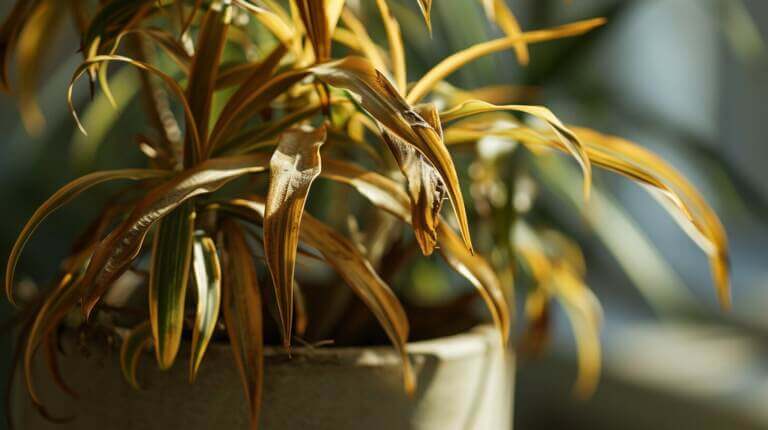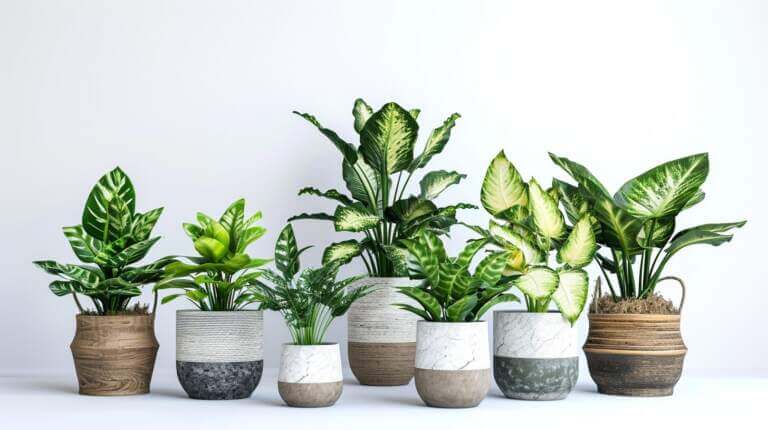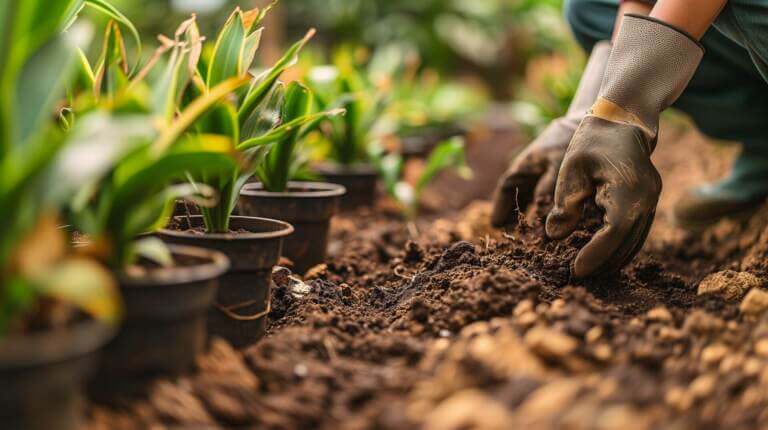Caring for a dracaena indoor plant is relatively easy and requires a few simple steps. With the right growing conditions, proper watering, and adequate light exposure, your dracaena can thrive as beautiful houseplants in your indoor space.
Key Takeaways:
- Provide the dracaena plant with filtered, bright, indirect light to ensure optimal growth.
- Avoid direct sunlight, as it can harm the leaves of the dracaena plant.
- Water the dracaena plant thoroughly when the soil dries out, but avoid constantly damp soil to prevent fungal growth and root rot.
- Choose nutrient-rich, well-draining potting soil with organic matter to promote healthy root growth.
- Maintain a temperature above 65°F and protect the plant from sudden coldness to prevent leaf damage.
- Higher humidity levels are beneficial for dracaena plants, especially during summer or in dry indoor environments.
- Fertilize the dracaena plant monthly during the growing season with a diluted liquid fertilizer or fish emulsion for optimal nutrition.
- Dracaena plants are toxic to pets, so keep them out of reach from animals to ensure their safety.
Getting to Know the Diverse Dracaena Varieties: Popular Varieties Explained
When it comes to varieties of dracaena houseplants, there’s a whole extended species of dracaena family to get to know beyond just dear old grandma Dracaena marginata. From petite cousins to towering uncles, dracaenas come in a wide range of shapes, sizes, and styles to suit any indoor garden. Here’s a quick cheat sheet for telling who’s who at the dracaena reunion.
The youngster Dracaena fragrans ‘Massangeana’ is known for its lime green racing stripe down the center of its leaves. It’s the kid zipping around with boundless energy. Meanwhile, mature Dracaena deremensis is the wise old aunt imparting knowledge. Her solid green leaves stretch up to the ceiling like outstretched arms passing down stories.
Don’t let towering Dracaena marginata intimidate you – he’s a gentle giant who is perfectly content in corners. And of course, there’s the boisterous middle child Dracaena compacta, always seeking attention with its colorful leaves striped in cream, red, or lime yellow.
The twins Dracaena braunii and Dracaena goldieana look nearly identical, both sporting bushy foliage dotted with golden spots. Tell them apart by Goldie’s more upright stems! And finally, baby Dracaena reflexa ‘Song of India’ just wants to please with her gracefully drooping leaves.
The popular types of dracaena plants family offers diverse personalities, shapes, and styles to complement any indoor garden. Once you learn who’s who, you can pick the perfect variety to become your new plant BFF based on your space and needs. Though one thing’s for sure – they’ll all provide the same easygoing, lush style the dracaena clan is known for. Ready to start growing dracaena plants?
Providing the Right Amount of Light
To care for your indoors dracaena houseplant, it is crucial to provide it with the appropriate amount of light. Light conditions play a significant role in the health and growth of dracaenas. While some varieties can tolerate low light, most dracaenas thrive in filtered, bright, indirect light. It’s important to avoid placing them in direct sunlight, as this can cause damage to their foliage.
Dracaenas are native to tropical regions where they grow under the canopy of larger plants, receiving filtered sunlight. Mimicking these conditions in your home will help them thrive. Placing them near a north-facing window or a few feet away from a west or east-facing window is ideal. If direct sunlight is unavoidable, using sheer curtains or blinds can help filter the intensity of the light.
In addition to the right amount of light, it’s important to ensure consistent light conditions. Dracaenas can be sensitive to changes in light levels, so avoid moving them frequently. If you notice your dracaena’s leaves turning yellow or drooping, it may be a sign that it’s not receiving enough light. On the other hand, if the leaves become pale and bleached, it may indicate too much light exposure.
Overall, providing the right amount of light for your dracaena plant will contribute to its overall health and appearance. By placing them in an area with filtered, indirect light, you can ensure they receive the optimal conditions for growth and foliage development.
Watering Guidelines for Dracaena Plants
Proper watering is essential for the health and well-being of your dracaena plant. While these plants are known for tolerating drought, they require regular watering to thrive. It’s important to strike a balance, as overwatering and underwatering can harm the plant’s overall health.
When it comes to watering your dracaena, it’s best to follow the “soak and dry” method. This means water your dracaena thoroughly until the water drains out from the bottom of the pot and then allowing the soil to dry out before thoroughly water your plant again. Generally, water your dracaena when the top few inches of soil feel dry to the touch. Avoid watering too frequently, leading to root rot and other issues.
To ensure proper drainage, using a well-draining potting mix is important. Most pre-mixed potting soils will work fine, but be sure to check that they have good drainage properties. If the soil you’re using retains too much moisture, add some perlite or sand to improve drainage.
| Watering Tips for Dracaena Plants | Do’s | Don’ts |
|---|---|---|
| Do | – Thoroughly soak the soil when watering | – Do not let the plant sit in standing water |
| Do | – Water when the top few inches of soil are dry | – Do not water too frequently |
| Do | – Use filtered, rainwater, or distilled water | – Do not use water with high mineral content |
| Do | – Monitor the moisture levels of the soil | – Do not let the soil dry out completely |
In addition to proper watering, it’s important to monitor the soil’s moisture levels. While dracaenas can tolerate periods of drought, it’s crucial not to let the soil dry out completely. This can cause the plant to become stressed and lead to leaf drop or other issues. On the other hand, overwatering can lead to root rot and the development of fungal diseases.
By following these watering guidelines, you can ensure that your dracaena plant receives the right amount of moisture and remains healthy and vibrant. Remember to observe your plant closely and adjust your watering routine based on its specific needs. With proper care and attention, your dracaena will thrive and bring beauty to your indoor space.
Choosing the Right Soil for Dracaena Plants
Selecting the right soil is crucial for the optimal growth of your dracaena plant. Dracaenas require nutrient-rich, well-draining potting soil that still allows moisture to reach the roots. Fortunately, most commercially available potting soils are suitable for dracaenas, but it’s important to ensure the presence of organic matter to enhance the soil’s fertility and water retention capabilities.
To create a suitable potting mix, consider adding organic matter such as coco-coir, peat moss, or shredded leaves. These materials not only enrich the soil with nutrients but also improve its water-holding capacity. By incorporating organic matter, you will create a balanced environment for your dracaena’s roots to thrive.
It’s worth noting that while a well-draining soil is crucial, soil that drains too quickly may require repotting into a compost-rich soil mixture with fewer drainage materials. This will help retain moisture for a longer period, ensuring that your dracaena’s roots stay hydrated.
| Key Considerations for Choosing Soil for Dracaena Plants |
|---|
| 1. Nutrient-rich: Look for potting soil that contains essential nutrients for plant growth. |
| 2. Well-draining: Ensure that the soil allows excess water to flow out to prevent waterlogging and root rot. |
| 3. Organic matter: Incorporate coco-coir, peat moss, or shredded leaves to enrich the soil and improve water retention. |
| 4. Consider repotting: If the soil drains too quickly, repot your dracaena into a compost-rich mixture with less drainage materials. |
By selecting the right soil and providing your dracaena plant with the necessary nutrients and moisture, you create an ideal environment for its growth. Remember to regularly monitor the soil’s moisture levels and adjust your watering routine accordingly. With the right care and attention, your dracaena plant will flourish and add beauty to your indoor space.
Temperature and Humidity Considerations
Dracaena plants have specific temperature and humidity requirements to thrive. Maintaining the right conditions is crucial for their overall health and well-being.
When it comes to temperature, it’s important to keep dracaenas in an environment that stays above 65°F (18°C). Sudden drops in temperature can cause damage to their leaves, so it’s best to avoid placing them near drafty doors or windows during colder months.
Humidity levels are also important for dracaenas, especially during the summer months or when they are exposed to heated, forced-air environments. These plants benefit from higher humidity levels. If the air in your home is dry, you can increase humidity by placing the plants in naturally humid areas, such as the bathroom or near a kitchen sink. Another option is to use a humidifier or use a tray filled with pebbles to increase moisture in the air around the plants. filled with pebbles and water
| Temperature Tips | Humidity Tips |
|---|---|
| Avoid exposing dracaenas to sudden cold drafts | Place the plants in naturally humid areas, such as the bathroom or near a kitchen sink |
| Maintain a temperature above 65°F (18°C) | Use a humidifier or create a pebble tray with water |
| Keep dracaenas away from drafty doors and windows during colder months | Monitor humidity levels and adjust as needed |
Here’s a helpful tip: if you notice brown and brittle leaf tips on your dracaena, it may be a sign of low humidity. By ensuring the right temperature and humidity conditions, you can promote optimal growth and keep your dracaena plants healthy and vibrant.
When to Repot Your Dracaena Marginata: Signs It’s Time for a Bigger Pot
Deciding when to repot your dracaena marginata is a lot like figuring out when it’s time to size up your favorite pair of jeans. At first the fit is perfect, but after a growth spurt, things start feeling a little too snug and restrictive. And just like an uncomfortable waistband, remaining in a small pot for too long can stunt your plant’s growth and health.
Typically, you’ll want to repot a dracaena marginata every 2-3 years, or whenever you notice roots crowding the surface or escaping from the drainage holes at the bottom. This is a clear sign that your plant is getting pot-bound and hungry for more space to stretch its roots.
When sizing up your dracaena’s home, go up just 1-2 inches wider than its current pot. This backpack-to-purse sized upgrade gives the root system room to expand without overwhelm. And make sure your pot has drainage holes! A dracaena marginata in a pot without holes is like a fish trapped in a water bottle – soggy soil means certain rot.
Use fresh, sterile potting mix to avoid transferring any diseases. While you’re at it, tidy up any dead lower leaves or wayward stems to give your dracaena marginata a rejuvenating makeover. Once rehomed, water thoroughly and let the soil dry out a bit before your next drenching session.
With the room to spread its roots and grow, your dracaena will thank you for the pot-up. And remember, just like jeans, it’s better to size up earlier rather than waiting until the seams are nearly splitting. An annual check-in ensures your plant is never bursting at the roots.
FAQ
How much light does a dracaena plant need?
Dracaena plants thrive in filtered, bright, indirect light. Dracaenas can grow and tolerate low light conditions, but direct sunlight should be avoided as it can shock the plant and damage the leaves.
How often should I water my dracaena houseplants?
Water your dracaena plant when the soil is dry, about four inches below the top. They don’t need frequent or much water, but a thorough soaking is necessary when the soil dries out for dracaena to grow new leaves for several months during the growing season.
What kind of soil is best for dracaena plants?
Dracaena plants require well-draining potting soil that contains plenty of organic matter, such as coco-coir, peat moss, or shredded leaves. The soil should be nutrient-rich and allow moisture to reach the roots.
What temperature range is ideal for dracaenas?
Dracaena plants prefer temperatures above 65°F. Sudden coldness can damage the leaves, so it’s important to keep them away from drafty doors and windows during colder months.
How can I increase humidity for my dracaena plant?
Dracaenas benefit from higher humidity levels, especially in heated, forced-air environments. To increase humidity, you can set the plants in naturally humid areas or use a humidifier or pebble tray with water. You can also move the plant to a bathroom for higher humidity.
Do I need to fertilize my dracaena plant?
While not necessary, dracaena plants can benefit from monthly feedings with a diluted liquid fertilizer designed for indoor plants or fish emulsion during the growing season. Top-dressing with organic compost is also beneficial at the start of the growing season.
Are dracaena plants toxic to pets?
Yes, dracaena plants are toxic to pets. It’s important to keep the plant out of reach from animals to avoid any potential harm.







